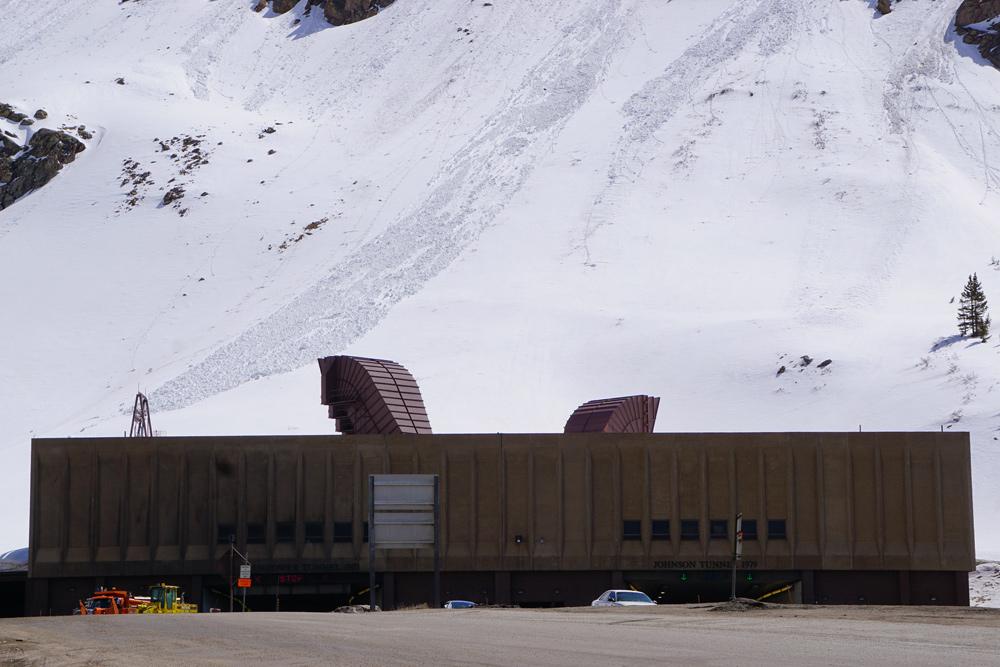Eisenhower Tunnel
Full Article
The Eisenhower-Johnson Memorial Tunnel (also known simply as the Eisenhower Tunnel) carries Interstate 70 traffic underneath the Continental Divide. The 1.6-mile-long pair of tunnels, carrying two lanes of traffic east and west, respectively, is seventy miles west of Denver in Summit County and provides an important transportation link for Western Slope and Front Range commerce, the ski industry, and tourism throughout the state. At 11,155 feet above sea level, they are the highest vehicle tunnels in the United States.
Fully opened for traffic in 1979, the tunnels today carry an average of roughly 30,000 cars per day, a number that peaks at 40,000 in July. During a busy holiday weekend, as many as 50,000 cars might pass through in a day. A massive ventilation system pumps fresh air throughout the tunnels, while a security team in a control room monitors remote video feeds to control traffic and keep motorists safe. Fifty-two full-time employees work at the tunnels to clear roads, watch surveillance monitors, remove snow, and perform other maintenance duties. Their efforts have paid dividends with an impressive safety record – to date, nearly 400 million cars have passed through the tunnels without a single fatality.
Prior to the construction of the tunnels and Interstate 70, vehicles crossed the Continental Divide by driving over Loveland Pass (11,922 feet) on Highway 6, a winding two-lane highway that could take more than an hour to navigate. In 1956, President Dwight D. Eisenhower signed the Federal Aid Highway Act, which authorized the federally funded construction of an Interstate Highway System in the United States. The original highway planners had no intention of constructing an interstate through the formidable Colorado Rockies, which many believed would be too expensive and too difficult. However, Colorado governor Edwin C. “Big Ed” Johnson and members of the state’s congressional delegation lobbied federal officials to extend Interstate 70 through the Rocky Mountains. Johnson and his supporters argued that the interstate would pay for itself through the increase in commerce, especially money from tourism. The federal government eventually agreed to extend the interstate through Colorado and to pay 90 percent of the construction costs; the state was responsible for the remaining 10 percent.
Construction on the tunnels beneath the Continental Divide proved difficult, expensive, and dangerous. Digging on the first tunnel started in March 1968, with the goal of opening it in three years. However, the engineers and construction workers quickly discovered that the project was going to be more difficult than originally planned. Harsh winters made for short work years outside the tunnel, and the men and equipment did not work as well at the high altitude. Inside the tunnel, miners discovered fragile rock layers the engineers had not anticipated, and the mountain could not support itself once certain sections had been dug through. With a little ingenuity, however, the crews devised a way to bore through the tunnel without triggering a collapse, and the tunnel continued to inch deeper into the mountain.
Among the project’s large workforce, Janet Bonnema deserves special attention. The Colorado Highway Department mistakenly hired her, a highway engineer with a degree from the University of Colorado, because they believed they were hiring a well-qualified “Mr. Bonnema.” When Bonnema arrived on the job, she was not allowed to enter the tunnels, even though it was her job to do so as an engineering technician. She was kept outside the tunnels and at a desk because construction workers believed having a woman in the tunnels would jinx the worksite. The taboo was so widely believed that on the day Bonnema finally entered the tunnels – surrounded by reporters, many of them also women– most of the work crew walked out of the tunnel, some of whom never returned to the job. The majority of the crew, however, returned to work the next day, and Bonnema continued to work in the tunnels, often dressed in loosely fitting coveralls so no one could tell her identity.
After five years of construction, the first tunnel opened for highway traffic on March 8, 1973. The eastbound tunnel opened for traffic six years later, on December 21, 1979. When it opened, the Eisenhower-Johnson Memorial Tunnel was the highest mountain tunnel in the world. It has since been surpassed by several railroad tunnels in Asia, but it remains the highest vehicular tunnel in the world and the highest point in the US Interstate Highway System.
The project went far over budget, totaling more than $257 million by the time both tunnels were finished, a sum Colorado transportation historian Thomas A. Thomas noted was “approximately equal to the original estimate of the entire stretch of Interstate 70 from Denver to the Utah state line.” All told, more than 1,000 men and women worked six days a week year-round to complete the tunnels. Despite safety precautions, three people lost their lives constructing the first bore of the tunnel and four on the second bore, and many others suffered amputations, surgeries, and a wide variety of other work-related injuries.
The work and sacrifices of these men and women made the commute from the Front Range to the Western Slope much easier and helped increase access to the high country. A drive through the tunnels from one side of the Continental Divide to the other takes about five minutes, while a trip over Loveland Pass can still take more than an hour. The shorter and much safer commute has strengthened commercial ties between the Front Range and the Western Slope. It has boosted the economy for many mountain towns and is a boon for skiers, snowboarders, and anyone else who wishes to visit or live in the Colorado Rocky Mountains.



